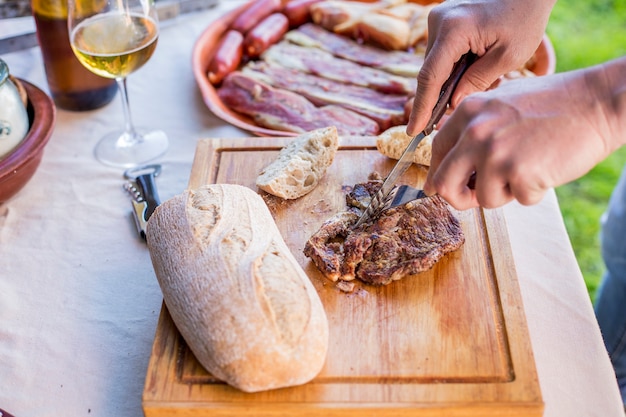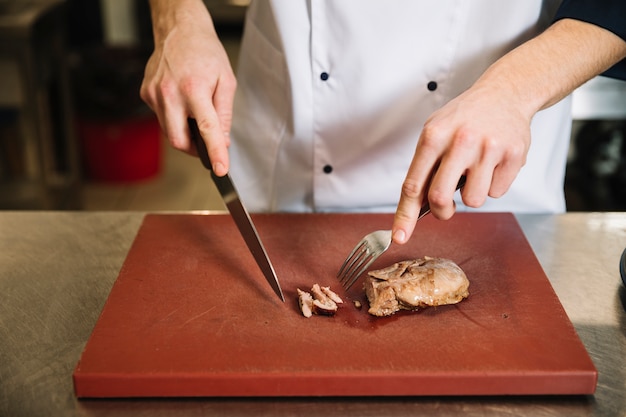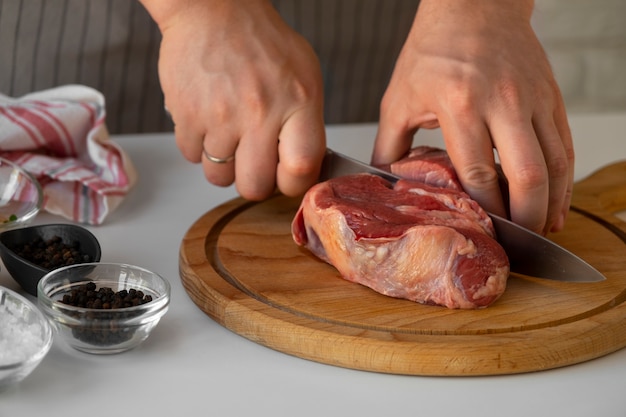Let’s be honest, a juicy, perfectly cooked pork chop is a culinary triumph. It’s a classic dish that can be enjoyed in countless ways, and it’s a dish that, frankly, everyone should master. I've been cooking for years, and I've learned a thing or two about getting those pork chops just right. It's not just about the time, you know. There's a science to it, and I'm here to share all the secrets I’ve learned over the years. So grab a cuppa, settle in, and let's get into it.
(Part 1) Picking the perfect pork chops

The first step to a delicious pork chop is selecting the right cut. This is where you lay the foundation for a truly successful dish. Think of it like choosing the right ingredients for a cake – if you start with subpar ingredients, the final product will suffer.
Bone-In vs. Boneless: Which is Best?
Now, you’ve got a choice to make: bone-in or boneless? I'm a firm believer in bone-in chops. They just seem to hold their moisture better, and the bone adds a lovely depth of flavour. It's like a little extra secret ingredient. Plus, there’s something about the presentation of a bone-in chop that just screams “gourmet”. But, if you're after something quicker and easier, boneless chops are definitely a good option.
The Importance of Thickness
No matter which type you choose, the thickness is crucial. You want something around an inch thick for the best results. Why? Because thinner chops cook faster and can easily become overcooked and dry. An inch thick gives you a good balance of cook time and tenderness.
Inspecting Your Pork Chops
Once you've picked your chops, give them a good look over. You want ones that are a nice, even colour, with a healthy pink hue, without any discolouration or blemishes. And don’t be afraid to give them a little sniff – they should smell fresh, not sour or off.
The Role of Fat
Now, let’s talk about fat. A little bit of fat is a good thing, it adds flavour and helps keep the meat moist. But too much fat can make your chops greasy, and frankly, nobody wants that. Look for chops with a moderate amount of marbling – just enough to add flavour and tenderness, but not so much that it overwhelms the dish.
(Part 2) Preparing Your Pork Chops for Success

You’ve chosen your chops, now it's time to get them ready for cooking. This is where you build a foundation for flavour and tenderness. Think of it like prepping your canvas before you start painting – you want to make sure it’s clean and ready to receive the masterpiece you have in mind.
Seasoning: Simple is Often Best
I’m a firm believer in keeping things simple when it comes to seasoning. Salt and pepper, that's all you really need. Let the natural flavour of the pork shine through! But feel free to get creative. If you’re feeling adventurous, try a little paprika, garlic powder, or even a pinch of cayenne pepper. Just remember, less is more, you don't want to overpower the flavour of the pork.
Browning: A Game-Changer
Browning your pork chops before cooking them is a bit of a game changer. It adds a delicious crust and helps lock in the juices. To brown them, get a pan good and hot, add a little oil, and sear those chops for about 2-3 minutes on each side. Don’t be tempted to rush it. Let them get a nice golden-brown colour before flipping them. It’s worth the wait, I promise.
(Part 3) Cooking Times: Decoding the Doneness

Here comes the part we’ve all been waiting for: the cooking times. This can be a bit of a minefield, but don’t worry, I'll break it down for you. Just remember, these times are for bone-in pork chops, around an inch thick. If you're using boneless chops, you'll need to adjust them a bit. And always, always use a meat thermometer to ensure your pork chops are cooked to a safe internal temperature of 145°F.
The Spectrum of Doneness: A Guide to Your Preferences
Let's explore the different levels of doneness and what they mean for your pork chop experience.
- Rare (130-135°F): The center is pink with a slightly red hue. Think of it like a steak, really. The texture is tender and juicy, with a bit of a bite. I'm not gonna lie, I'm a fan of rare pork chops, but I know not everyone is. So, if you're feeling adventurous, give it a try!
- Medium-Rare (140-145°F): Still pink throughout, but with a hint of brown around the edges. It's still juicy and tender, but not quite as raw as rare. You're looking at about 4-5 minutes per side for medium-rare.
- Medium (150-155°F): A popular choice for a reason. The inside is still pink, but the outer edges are brown, giving it a nice balance of flavour and texture. For medium, you're looking at about 5-6 minutes per side.
- Medium-Well (160-165°F): If you prefer your pork chops with a little more "done", medium-well is the way to go. The inside will have a touch of pink, but it's mostly brown. The texture is a little less juicy, but still tender. You'll need about 7-8 minutes per side for medium-well.
- Well-Done (170°F): For those who like their meat cooked through and through. The inside will be brown, with a slightly firm texture. It's not as juicy as the other levels of doneness, but it's still a good option. For well-done, you're looking at about 9-10 minutes per side.
(Part 4) Cooking Methods: Choosing the Best Fit
Now, we've talked about the cooking times, but there are a few different ways to cook your pork chops. The method you choose will affect the final result, so it's worth considering your options.
Pan-Frying: A Classic Choice
Pan-frying is a classic way to cook pork chops. It's simple, quick, and produces a nice crust. Just get a good pan hot, add some oil, and sear those chops on each side. You can also add other ingredients to the pan, like onions, garlic, or herbs, for extra flavour.
Grilling: Summertime Delights
Grilling is another great way to cook pork chops, especially in the summer. It gives them a smoky flavour and a nice char. Just make sure your grill is hot, and don't overcook them. I like to grill them over medium heat for about 4-5 minutes per side.
Baking: A Hands-Off Approach
Baking is a great option if you're looking for a hands-off method. Just preheat your oven to 375°F, place your seasoned pork chops on a baking sheet, and bake for about 20-25 minutes, or until cooked through. This is a good way to cook several chops at once.
(Part 5) Checking for Doneness: Mastering the Art of the Test
So you've cooked your pork chops according to the time, but how do you know if they're actually cooked through? Don't rely on just the timer, you need to do a proper check.
The Meat Thermometer: Your Culinary Ally
The best way to make sure your pork chop is cooked to your desired doneness is with a meat thermometer. It's a simple tool that takes the guesswork out of cooking. You want to make sure the internal temperature reaches the safe minimum temperature of 145°F. This will ensure that the meat is cooked through and safe to eat.
The Poke Test: A Simple Visual Cue
I also like to give the chops a little poke. They should be firm and spring back when you press on them, not jiggly or mushy. This is a good indication that the meat is cooked through.
(Part 6) Resting Your Pork Chops: A Key to Juiciness
Once your pork chops are cooked, it's important to let them rest for about 5-10 minutes before slicing and serving. This helps the juices redistribute, making for a juicier, more flavorful chop. You can cover them loosely with foil to keep them warm while they rest.
(Part 7) Serving Your Pork Chops: A Symphony of Flavours
Now, what's a good pork chop without some sides? I love a good mash potato, but you can also serve them with roasted vegetables, salads, or even a simple rice pilaf.
The Power of Sauce: Enhancing Your Dish
And don't forget the sauce! A little bit of gravy can really make a pork chop sing. You can make your own, or buy some premade if you're short on time.
(Part 8) Troubleshooting: Saving the Day
We've all been there, right? The pork chops are looking a bit dry, or maybe they're a bit overcooked. Don't despair! There are a few things you can do to save the day.
Dry Pork Chops: Adding Moisture
If your pork chops are dry, there are a few things you can do. First, try adding a little bit of sauce to the pan, and let it simmer for a few minutes. This will help add some moisture back to the meat. You can also try wrapping the chops in foil and letting them rest for a few minutes. This will help steam the meat and rehydrate it.
overcooked pork Chops: Making the Most of a Situation
Overcooked pork chops are a bit trickier to salvage, but not impossible. You can try slicing them thin, and then adding them to a stew or casserole. This is a great way to use up any leftover pork chops, too.
(Part 9) Leftover Pork Chops: Creative Culinary Solutions
Let’s be honest, sometimes you're left with leftover pork chops. And I'm here to tell you, that's not a bad thing! There are a few ways to make the most of them.
Reheating for a quick and easy meal
The simplest thing you can do is reheat them in the oven or microwave. Just make sure they're heated through, and you can serve them with a side of your choice.
Pork Chop Salad: A Light and Refreshing Option
You can also chop up leftover pork chops and add them to a salad. This is a great way to get a light, refreshing meal. I like to add some chopped tomatoes, cucumbers, and red onions, and a simple vinaigrette.
Pork Chop Soup: A Hearty and Savory Delight
Another great option for leftover pork chops is to make a soup. Just dice up the chops, and add them to your favourite soup recipe. This is a great way to use up any leftover vegetables, too.
Pork Chop Sandwiches: A Flavorful Twist on a Classic
If you're feeling fancy, you can also use leftover pork chops to make sandwiches. Just slice them thin, and serve them on bread with your favourite toppings. I love a good pork chop sandwich with a dollop of mustard and a slice of tomato.
(Part 10) FAQs: Addressing Your Pork Chop Queries
Right, let's tackle some of your burning questions about pork chops.
1. How long can I store pork chops in the fridge?
Fresh pork chops can be stored in the refrigerator for 3-5 days. Just make sure you wrap them tightly in plastic wrap or aluminum foil to prevent freezer burn.
2. Can I freeze pork chops?
Yes, you can definitely freeze pork chops! Just wrap them tightly in plastic wrap or aluminum foil, and then place them in a freezer-safe bag. Frozen pork chops can last for 4-6 months.
3. How do I thaw frozen pork chops?
There are a few ways to thaw frozen pork chops. You can thaw them in the refrigerator overnight, or you can thaw them in a bowl of cold water. Just make sure to change the water every 30 minutes. You can also thaw them in the microwave, but this is not recommended as it can cook the meat unevenly.
4. What are the signs of spoiled pork chops?
Spoiled pork chops will have a sour or off smell. They may also be discoloured or slimy. If you notice any of these signs, it's best to throw the chops away.
5. Can I eat pork chops that are pink?
Yes, you can eat pork chops that are pink, as long as they are cooked to a safe internal temperature of 145°F. The USDA used to recommend cooking pork to 160°F, but they have since lowered the recommendation to 145°F. So, if you're a fan of rare or medium-rare pork chops, go for it!
So there you have it, folks. My tips and tricks for cooking the perfect pork chop. It's all about finding what works for you. Don't be afraid to experiment, and most importantly, have fun!
Everyone is watching

Prime Rib Roast Cooking Time Chart: Per Pound Guide
Cooking TipsPrime rib roast. Just the name conjures images of lavish dinners, crackling fires, and hearty laughter. It’s ...

How Long to Bake Potatoes in the Oven (Perfect Every Time)
Cooking TipsBaked potatoes are a staple in my kitchen. They're incredibly versatile, delicious, and surprisingly easy to m...

Perfect Rice Every Time: The Ultimate Guide to Cooking Rice
Cooking TipsAs a self-proclaimed foodie, I've always been a bit obsessed with rice. It's the foundation of countless cuisi...

The Ultimate Guide to Cooking Asparagus: Tips, Techniques, and Recipes
Cooking TipsAsparagus. The mere mention of this spring delicacy conjures up images of vibrant green spears, crisp and burs...

Ultimate Guide to Cooking the Perfect Thanksgiving Turkey
Cooking TipsThanksgiving. Just the word conjures up images of overflowing tables laden with delicious food, the scent of r...
